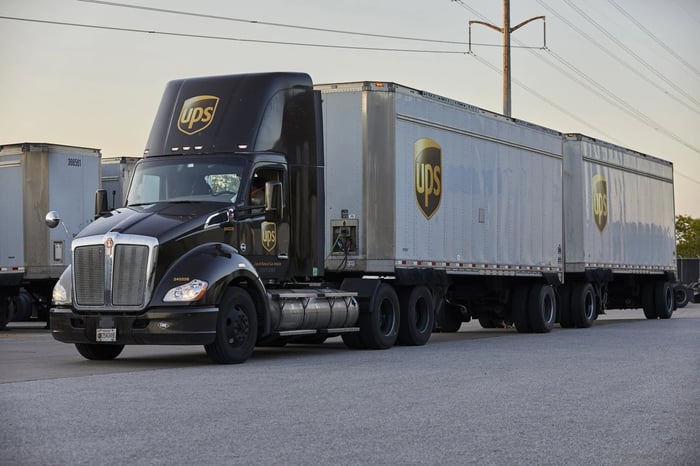Could Buying UPS Stock Today Set You Up for Life?

Key Points
UPS’ stock has tumbled over the past several years.
It’s struggled with labor issues, competition, and macro challenges.
Its low valuation and high yield should limit its downside potential.
UPS (NYSE: UPS), one of the world's largest shipping couriers, might seem like a reliable long-term investment. But over the past five years, its stock declined 40%. Even after including its reinvested dividends, it delivered a negative total return of 28%.
UPS struggled as its macro headwinds, labor disputes, and competitive challenges throttled its growth. But at $87, it trades at just 12 times next year's earnings and pays a hefty forward dividend yield of 7.6%. Should investors buy this unloved stock, collect its big dividends, and expect it to generate life-changing gains over the next few decades?
Where to invest $1,000 right now? Our analyst team just revealed what they believe are the 10 best stocks to buy right now. Continue »

Image source: UPS.
What happened to UPS over the past few years?
UPS' average daily package volume, average revenue per piece, and total revenue all increased in 2020 and 2021 as the pandemic drove more people to shop online. That rising demand enabled it to charge higher fees, which boosted its adjusted operating margins and earnings per share (EPS).
But in 2022 and 2023, its daily package volumes dipped as it lapped its pandemic-era growth spurt, inflation curbed consumer spending, and threat of a strike from the Teamsters drove some of its customers to shift their orders to other couriers like FedEx (NYSE: FDX). UPS tried to offset that pressure with price hikes, but its higher labor and fuel costs offset those gains, crushed its adjusted operating margins, and caused its EPS to plummet.
|
Metric |
2019 |
2020 |
2021 |
2022 |
2023 |
2024 |
|---|---|---|---|---|---|---|
|
Average Daily Package Volume |
21.88M |
24.68M |
25.25M |
24.29M |
22.29M |
22.42M |
|
Average Revenue Per Piece |
$10.87 |
$10.94 |
$12.32 |
$13.38 |
$13.62 |
$13.60 |
|
Total Revenue |
$74.09B |
$84.63B |
$97.29B |
$100.34B |
$90.96B |
$91.07B |
|
Adjusted Operating Margin |
11% |
10.3% |
13.5% |
13.8% |
10.9% |
9.8% |
|
Diluted EPS |
$7.53 |
$8.23 |
$14.68 |
$13.20 |
$7.80 |
$6.75 |
Data source: UPS.
In 2024, its daily package volume and revenue increased again as the macro environment stabilized and it negotiated a new labor contract with the Teamsters. But those higher labor and pension costs, its divestment of Coyote Logistics, regulatory fines in the U.S. and Italy, impairment charges, and investments in its digital ecosystem reduced its operating margins and EPS again.
UPS isn't out of the woods yet
In the first six months of 2025, UPS' average daily package volume declined 4% year over year to 20.26 million. Its average revenue per piece grew 4% to $14.28 as its adjusted operating margin expanded 50 basis points to 7%, but its revenue dipped 2% and its EPS fell 1%.
That decline was mainly caused by three strategic shifts. First, it accepted fewer shipments from Amazon (NASDAQ: AMZN), its largest customer, because those deliveries generated much lower margins than its deliveries for smaller customers. UPS aims to reduce its Amazon-related volumes by at least 50% by mid-2026. Second, it raised its prices to reduce its mix of lower-value shipments (like its Ground Saver economy service).
Lastly, it closed dozens of distribution centers and laid off thousands of workers to resize its business and offset the pressure from its new labor contracts. All these moves indicate that UPS will sacrifice its near-term revenue growth to strengthen its long-term margins, but it will struggle to grow its EPS until its top-line growth stabilizes again. The Trump administration's unpredictable tariffs on cross-border purchases -- and their effect on e-commerce orders from China to the U.S. -- could further complicate its recovery.
Don't count on UPS to deliver life-changing gains
UPS hasn't provided any revenue or earnings guidance for the full year. However, analysts expect its revenue and EPS to decline 4% and 7%, respectively, as it slogs through those aforementioned challenges. They expect UPS' revenue and earnings to finally grow modestly again in 2026 and 2027 after it slims down its business, but investors should take those estimates with a grain of salt.
It might be a good value play for income investors at these levels, since its low valuation and high yield should limit its downside potential. But investors looking for a stock that can set them up for life should probably avoid UPS and look for higher-growth plays with more upside potential.
Should you invest $1,000 in United Parcel Service right now?
Before you buy stock in United Parcel Service, consider this:
The Motley Fool Stock Advisor analyst team just identified what they believe are the 10 best stocks for investors to buy now… and United Parcel Service wasn’t one of them. The 10 stocks that made the cut could produce monster returns in the coming years.
Consider when Netflix made this list on December 17, 2004... if you invested $1,000 at the time of our recommendation, you’d have $653,427!* Or when Nvidia made this list on April 15, 2005... if you invested $1,000 at the time of our recommendation, you’d have $1,119,863!*
Now, it’s worth noting Stock Advisor’s total average return is 1,060% — a market-crushing outperformance compared to 182% for the S&P 500. Don’t miss out on the latest top 10 list, available when you join Stock Advisor.
*Stock Advisor returns as of August 4, 2025
Leo Sun has positions in Amazon. The Motley Fool has positions in and recommends Amazon, FedEx, and United Parcel Service. The Motley Fool has a disclosure policy.





